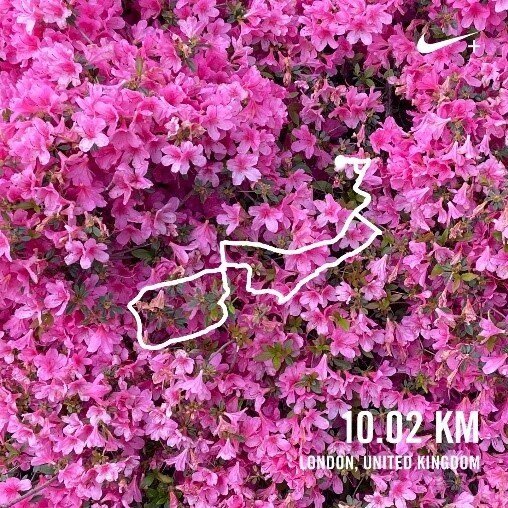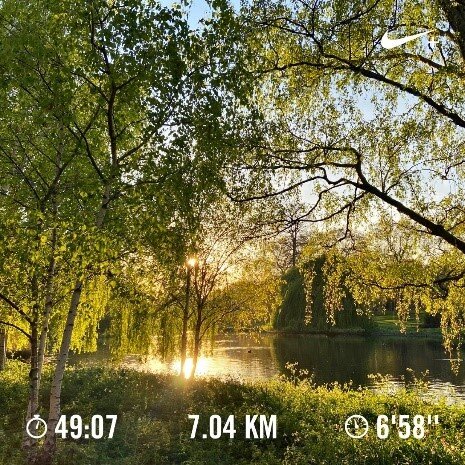Sanjidah Sabur
The Science and Serenity of the Runner’s High
When the pandemic hit it seemed like winter had just packed its bags for Covid-19 to move in.
During the start of the nation-wide lockdown I struggled, like many others, with cabin fever and dreamt of vitamin-D-soaked frolics with friends. However, as the government instructed us to be more antisocial than ever, I managed to find an outdoors way to calm my anxiety whilst maintaining social distancing. A solo run was the perfect way– through the power of technology and neurochemistry. I was able to enjoy the freshly bloomed flowers and bright spring sunshine – and catch a runner’s high too.
How can you get started? It can be as simple as popping on your trainers - heading out the door – and seeing where the wind takes you. Or your runs can be incredibly varied; from a thrilling, drum’n’bass pumped morning workout to a therapeutic, meditative run savouring a sunset.
The Science of Runner’s High

You may have heard the term ‘runner’s high’ thrown around before. It is a common – and highly desired – effect caused by any intensive cardioactive exercise.
You may have heard the term ‘runner’s high’ thrown around before. It is a common – and highly desired – effect caused by any intensive cardioactive exercise.
It answered my questions as to why people put up with such an unnecessarily painful activity. When you are pounding the pavement, the physical stress on your body releases the stress hormone, cortisol. This bursts open the gates to a happy flood of endorphins and endocannabinoids, the chemicals responsible for the sensation of elation and euphoria during your run.
Endorphins act similarly to the pain-killing effects of morphine. However, endocannabinoids play a greater role, the bodies naturally synthesised version of THC, the same chemical that causes marijuana’s high. Anandamide is the endocannabinoid which can be synthesised by all the cells in our body, therefore neurotransmitting greater volumes of serenity to our brain.
Although I now prefer to have culinary delights delivered to my doorstep, back in the day our ancestors needed high speed and endurance to hunt whilst remaining motivated and energised. This brain chemical tag-team promoting exhilaration and euphoria still occurs in our bodies.
So how can you achieve this affect? If you are lucky enough to have the countryside at your doorstep, you’ll be soaking in the surroundings whilst having a stimulating yet relaxed run. However, as I live in the city a lush gorgeous park seems to cut the mustard.

A bonus tip and one I always do is to have my favourite tunes playing.
Music is known to spike your level of endorphins.
Something special happens when the chorus hits and you build the momentum to accelerate downhill. Playing instrumental music without the distraction of lyrics has also helped me get in the zone and practice mindful running. I always find when I adopt this mindset, I have a new appreciation for floral pops of colour and the wide wash of blue across the sky.
I also enjoy zipping about at different times of the day to vary the experience. I find morning runs can get rid of my anxiety jitters. However, I tend to prefer runs in the evenings. There is something about running over London’s many bridges during a gorgeous lilac sunset that is unlike anything else. The more I practice and bring my fitness up, the longer I am able to run for and guarantee that runner’s high.
Mindful Running
I have found using meditation to practise deep breathing has helped to dissipate the downward spiral of negatives thoughts I feel when I am anxious. Better yet – when I’m feeling particularly energetic – practising meditation with running has been a productive way to release physical tension and stimulate blood flow. Focusing my thought process with mindful running has been useful to detangle conflicting thoughts and calm my mind. Alternatively, when I want to switch things up, I ditch the headphones for a mindfulness run. I found it’s a great way to deal with my anxiety – especially during this pandemic. When I feel anxious, I am usually unaware of the loss of control of my breathing. It will have become quick shallow breaths from the chest which signal stress responses such as tense muscles, dizziness and a rapid heart rate. A sure-fire way to counteract this is with deep breathing.
I try to get in the zone with a few methods. Before I start the run, I practise deep breathing, and during the run I try to match my steps with each breath. Another method includes observing the sounds and sights around you and making a mental checklist of what you see.
What you can count on is technology - especially during quarantine. There are a multitude of fitness apps such as MapMyRun and Strava. However, Nike Running Club have made their content free forever specifically for this time. A run-focused training app was and still is a great tool that got me started as a beginner. There are guided runs for meditation, a coach for speed and endurance, and highly Instagram-able feeds that show your specifications such as distance, time and pace in an aesthetic and non-competitive way.
If you were ever self-conscious about getting started, now could not be a better time. There are fewer crowds, less pollution and the tech, weather and neurochemicals are cheering you on. With London being the greenest city in Europe and the third greenest in the world, it seems like a no brainer. What are you waiting for?
Further Reading:
Wired to run: exercise-induced endocannabinoid signaling in humans and cursorial mammals with implications for the ‘runner’s high’
A Runner’s high depends on cannabinoid receptors in mice
Performance of Music Elevates Pain Threshold and Positive Affect: Implications for the Evolutionary Function of Music
——— ——— ———
This piece was first submitted as part four of an ongoing blog series, inspired by and reflecting back on the Science Gallery London exhibition ON EDGE: Living in an Age of Anxiety during the time of the Covid-19 Crisis and is reproduced here with the permission of the author.